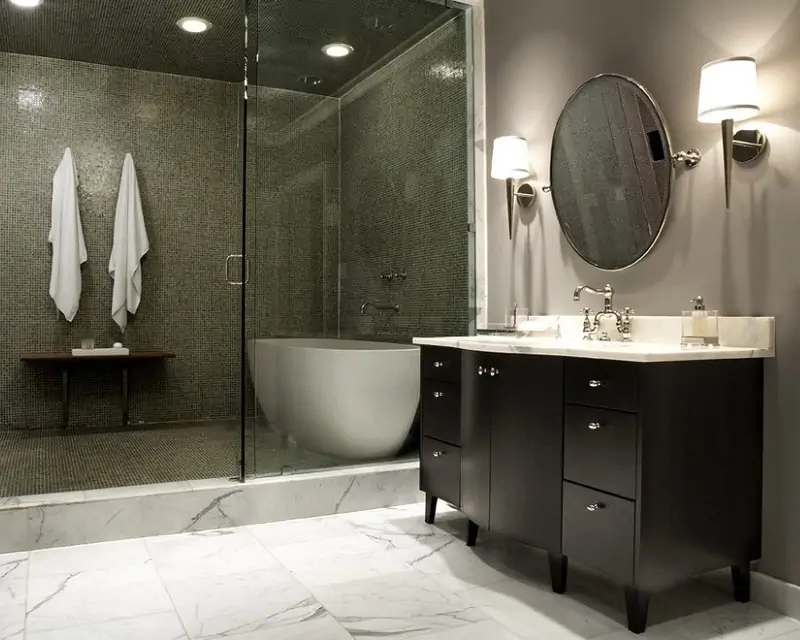The Pros and Cons of a Walk-In Bathtub vs. a Walk-In Shower
Tags
Walk-in Shower With Bathtub | The Pros and Cons of a Walk-in Tub | Walk in Tub Pros and Cons
The decision between a walk-in bathtub and a walk-in shower is one of the most important ones you’ll have to make when remodeling a bathroom.
Both choices appeal to various needs and tastes while having varied advantages and disadvantages.
To assist you in making an informed choice for your bathroom renovation project, we will examine the advantages and disadvantages of a walk-in bathtub versus a walk-in shower in this detailed guide.
Walk-In Bathtub: Luxurious Comfort Pros

Therapeutic Benefits
Walk-in bathtubs come equipped with water and air jets, offering therapeutic benefits like hydrotherapy and massage. These features can provide relief from various ailments, including arthritis, muscle pain, and stress.
Safety
Walk-in bathtubs are designed with safety in mind. They typically have a low threshold for easy entry and exit, non-slip flooring, and handrails. These features are especially helpful for individuals with mobility issues or seniors.
Hydrotherapy
Walk-in bathtubs’ capacity to accommodate deep soaking enables you to have a comfortable and opulent bath. The warm water helps relieve aching muscles and promote general well-being.
Aesthetics
Many walk-in bathtubs have exquisite designs that can improve your bathroom’s overall beauty. They frequently have different configurable choices, letting you pick what you want.
Walk-In Bathtub: Drawbacks Can’t be Overlooked
Space Requirements
Compared to showers, walk-in bathtubs are often larger and take up more room. Installing a walk-in bathtub might not be practical if your bathroom is small.
Installation Costs
Installing a walk-in bathtub might be more difficult and costly than installing a walk-in shower. Your plumbing and electrical systems might need to be changed, which would raise the entire cost.
Fill and Drain Time
A walk-in bathtub can take longer to fill and drain than a shower, which might not be convenient if you have a busy schedule.
Limited Mobility
While walk-in bathtubs are intended to provide safety for people with restricted mobility, they might not be appropriate for people who need a wheelchair due to severe mobility impairments.
Walk-In Shower Pros: Accessibility and Convenience

Accessibility
Walk-in showers are incredibly accessible, making them an ideal choice for individuals with mobility challenges. There are no high thresholds to step over, making entry and exit easy.
Space-Efficient
Walk-in showers are space-efficient and can be installed in smaller bathrooms, making them a practical choice for those with limited space.
Quick and Convenient
Taking a shower is generally quicker and more convenient than filling and draining a bathtub. It’s an excellent choice for people with busy lifestyles.
Easy to Clean
Walk-in showers are easy to clean and maintain, as they typically have fewer nooks and crannies compared to bathtubs.
Walk-In Shower Cons: Potential Drawbacks
Limited Relaxation
While showers are great for getting clean, they lack the relaxation and therapeutic benefits of a soak in a bathtub.
Safety Concerns
Walk-in showers may pose a slip hazard, especially if the flooring is not designed with non-slip materials. Adding handrails and other safety features can mitigate this concern.
Aesthetic Options
Walk-in showers may have fewer customizable options compared to walk-in bathtubs, which can limit your ability to match your bathroom’s decor.
Resale Value
Some potential homebuyers may prefer having a bathtub in at least one bathroom, so removing all bathtubs in your home in favor of walk-in showers could potentially lower your home’s resale value.
FAQs Walk-In Bathtub vs. a Walk-In Shower
Q. Can I convert my existing bathtub into a walk-in bathtub or shower?
A. Yes, it is possible to convert your existing bathtub into a walk-in bathtub or shower, but it depends on the structural feasibility and your budget. Consult with a professional contractor to assess your specific situation.
Q. Are walk-in bathtubs only suitable for the elderly and individuals with mobility issues?
A. While walk-in bathtubs are designed with safety in mind and are popular among seniors and those with limited mobility, they can be enjoyed by anyone who appreciates the therapeutic benefits of soaking in warm water.
Q. What are the maintenance requirements for walk-in bathtubs and showers?
A. Both walk-in bathtubs and showers require regular cleaning to prevent mold and mildew. Walk-in bathtubs may require additional maintenance for their water and air jets, while showers may need periodic grout and sealant maintenance.
Q. Can I install a walk-in bathtub or shower in a small bathroom?
A. Walk-in showers are more space-efficient and are better suited for smaller bathrooms. However, you can find compact walk-in bathtubs designed for smaller spaces if you prefer a bathtub.
Q. Which option is more cost-effective, a walk-in bathtub or a walk-in shower?
A. Walk-in showers are generally more cost-effective in terms of installation and maintenance. Walk-in bathtubs can be more expensive due to their specialized features and installation requirements.
Conclusion
Choosing between a walk-in bathtub and a walk-in shower ultimately depends on your preferences, needs, and bathroom design and space. Each option has its unique advantages and drawbacks.
Consider factors like safety, accessibility, space, and your personal bathing habits when making your decision. Consulting with a professional contractor can also help you determine the best choice for your specific bathroom renovation project.
Whether you opt for the luxurious comfort of a walk-in bathtub or the convenience of a walk-in shower, both can enhance your bathroom’s functionality and aesthetics while improving your overall bathing experience.






















